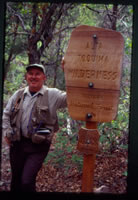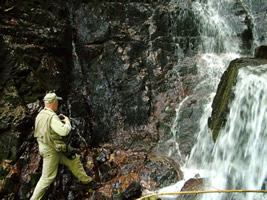|
Research Associate |
|||||||||||||||||||||||||
|
|||||||||||||||||||||||||
My
ongoing research interests are on moss floristics and basic
bryophyte inventory activities. My field work shifted around 1997
from flowering plants to bryophytes with an emphasis in
bryogeography through specimen acquisition to expand the diversity
of the collections within the herbaria of CAS and UC. Nine plant
species have been named in my honor including three mosses and the
moss genus Shevockia.
One of my most valuable contributions to science is my set of
herbarium specimens currently with over 41,000 numbers obtained
from western North America (especially California and Nevada),
China, Taiwan, Philippines, South Korea, Australia, New Zealand,
South Africa, São Tomé e Príncipe (Gulf of Guinea, west
Africa), Chile, and Rota and Hawaii in the Pacific Basin. All of
my flowering plant collections are housed at CAS with many early
numbered duplicates at RSA and for my bryophyte collections the
first set is at CAS with many duplicates at MO, NY, and UC. A
complete set of my Yunnan Province, China collections reside at E,
KUN and MO with many duplicates at H, NY, PE and UC, and a set of
my Taiwan collections are at the Taiwan Endemic Species Research
Institute (TAIE) and also at MO. Nearly half of my bryophyte
collections are the product of international expeditions with the
greatest number obtained in China primarily in the mountainous
region of Yunnan Province (the Gaoligongshan) along the border
with Myanmar in the Nu Jiang (Salween) and Irrawaddy river basins.
Another of my research interests is focused on the distribution
and ecology of rheophytic bryophytes. These species are restricted
to seasonally fast flowing rivers and streams where they are then
exposed for various times of the year (usually the summer season)
thereby requiring both the ability to be aquatic and deal with
extended periods of desiccation on exposed rocks. The number of
bryophytes that can be classified as "rheophytes" is probably
less than 500 species worldwide. Rheophytes also have a distinct
linear distribution pattern within the water column. Some
rheophytes occur along the high water mark while others are
submerged for extended periods forming distinct species zones.
Part of the ongoing inventory of rheophytic bryophytes led to the
discovery of a new rheophytic genus, Yunnanobryon,
described in 2011 from China.
I
received my B.S. (1976) and M.A. (1978) in Botany from California
State Univ., Long Beach. Upon graduation, I began my federal
public service career as the botanist/ecologist with the USDA
Forest Service, Sequoia National Forest (1979-84). In 1984 I
accepted at 2-year assignment approved by the Secretary of
Agriculture to assist the California Department of Fish & Game
as botanist of its Natural Diversity Database. In 1986, I was then
promoted to Regional Botanist for the USDA Forest Service, Pacific
Southwest Region stationed at that time in San Francisco (now Mare
Island, Vallejo, CA) where I administered the sensitive and rare
plant program across 18 national forests in California. In 1998 I
departed the Forest Service for a new opportunity to serve as the
Associate Regional Director for Resources, Stewardship &
Science for the USDI National Park Service, Pacific West Region,
headquartered in San Francisco. On February 1, 2004 I began my new
NPS role as research coordinator at the Californian Cooperative
Ecosystem Studies Unit duty stationed at U.C. Berkeley. I
officially retired from federal government service effective
January 2, 2009 so I could focus on more bryological expeditions
and my research interests. I am a research associate of the
Department of Botany, California Academy of Sciences since 1983,
and elected as a Fellow in 2007. I have served as President,
Corresponding Secretary and Council Member for the California
Botanical Society, Member at Large with the American Bryological
and Lichenological Society, Vice President for Plant Programs with
the California Native Plant Society and Secretary-Treasurer of the
International Association of Bryologists. My current office is
located at CAS.



